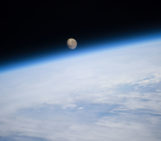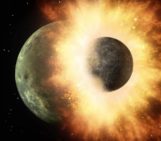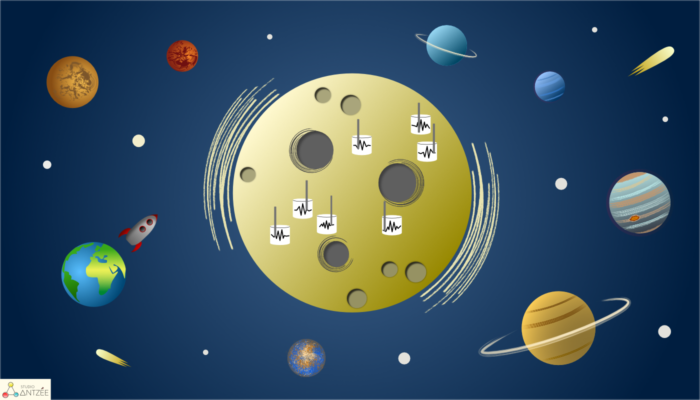

Alice Turner is a PhD student at the Department of Earth Sciences at the University of Oxford, working on deep moonquakes
The Moon is our nearest neighbour but despite its proximity to Earth its two faces are still veiled in mystery! This week PhD student Alice Turner from the University of Oxford explores deep lunar seismicity and what this can (or cannot!) tell us about the Moon’s interior and its near- & far-sides!
Outlining the Earth and its Moon with seismicity
Mapping out the locations of earthquakes has helped us understand the dynamic processes happening on our Earth; Earthquake foci outline plate boundaries and delineate subducting slabs as they descend into the mantle.
But what about our closest planetary neighbour? During the Apollo missions, four seismometers were placed on the near-side of the Moon (i.e., that lunar hemisphere that always faces towards Earth, see Fig. 1). And surprisingly, these instruments revealed that, although the Moon does not have plate tectonics, it’s still seismically active. Most of the lunar seismic activity occurs deep inside the Moon, at depths between 700 – 1200 km – that’s roughly halfway between the Moon’s surface and its centre! These deep moonquakes are driven by the Earth’s gravity which pulls faults deep inside the Moon just as the Moon’s gravity pulls the water of the oceans on the Earth’s surface, causing tides. These tidal deep-moonquakes happen in tight clusters, mostly on the near-side of the Moon. In this blog post, we’ll explore what the distribution of these deep moonquakes can (or can’t!) tell us about the Moon.
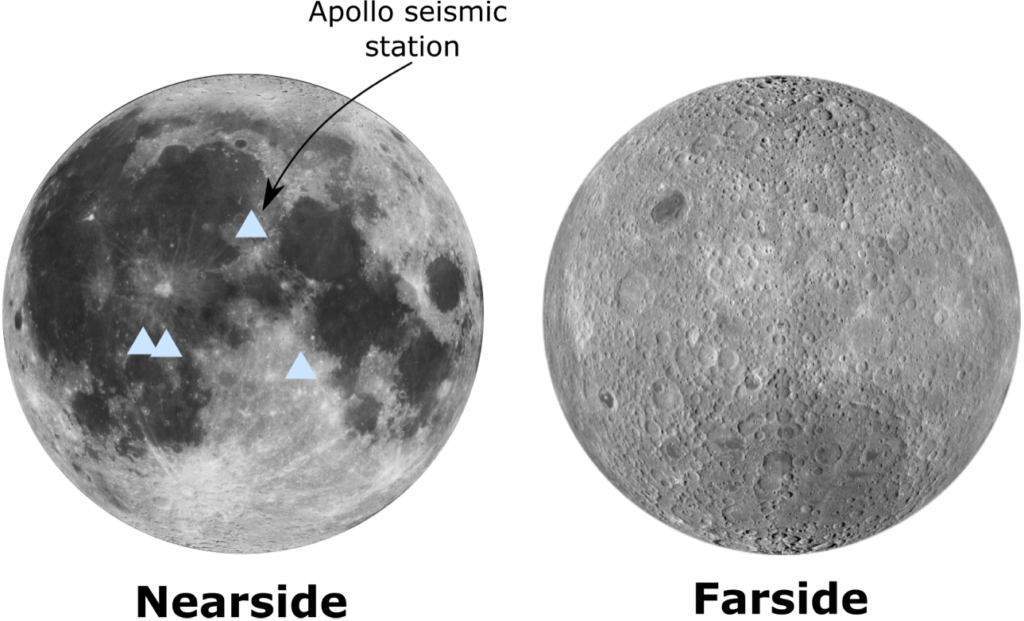
Figure 1: Near-side and far-side of the moon. The locations of the Apollo seismic stations on the near-side of the moon are shown as blue triangles. Images from NASA/Goddard/Arizona State University.
Locating deep moonquakes
Deep moonquakes are located using a seismic wave velocity model of the lunar interior, and the arrival times of the seismic waves (or phases) recorded by the seismometers on the Moon. But accurately picking out these phases is a challenge (Nunn et al., 2020). Part of the problem comes from the small magnitude of the deep moonquakes. The largest deep moonquake was only Mw 3 (Goins et al., 1981), and the resulting low amplitude signals are hard to spot on the seismogram.
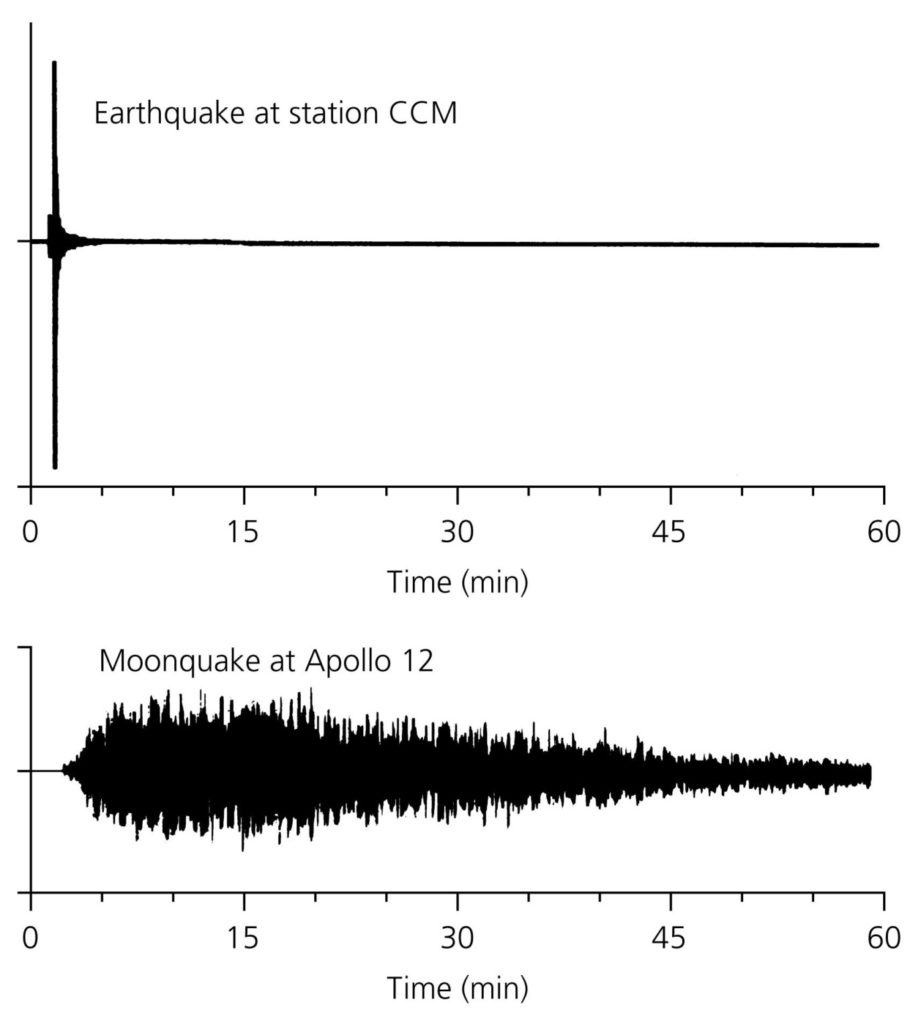
Figure 2: Comparison between an earthquake and moonquake seismogram (Figure 3.7-10, Stein and Wysession, 2009).
Another challenge comes from the strange shape of the lunar seismograms (Fig. 2). Compared to seismograms from Earth, the lunar seismograms have very long durations with a long decaying tail of energy. These long seismograms result from the scattering of seismic energy. The highly fractured outer shell of the Moon bounces energy around, and the Moon is inherently inefficient at reducing the amplitude of the seismic signal (the Moon has a low intrinsic attenuation). The scattered and attenuated signal can continue to arrive at a station hours after an event. All this scattered energy makes it harder to spot the seismic phases we need to locate the deep moonquakes.
In addition to the quirks of the lunar waveforms, poor knowledge of the lunar seismic velocity structure also adds uncertainty to the event locations (Nunn et al., 2020, Garcia et al., 2019). And finally, near-side locations of the Apollo seismic stations (Fig. 1) may prevent us from spotting some deep moonquakes or accurately locating the ones we do find.
All these factors mean the uncertainty of the deep moonquake locations can be hundreds of kilometres (Garcia et al., 2019). Even accounting for this, of the around 165 located deep moonquake nests, only around 30 are likely to be on the far-side (Nakamura, 2005), and no deep moonquakes at all have been located within 40 degrees of the antipode of the seismic network– the distribution of well-located deep moonquakes is asymmetric (Nakamura, 2005, Fig. 3).
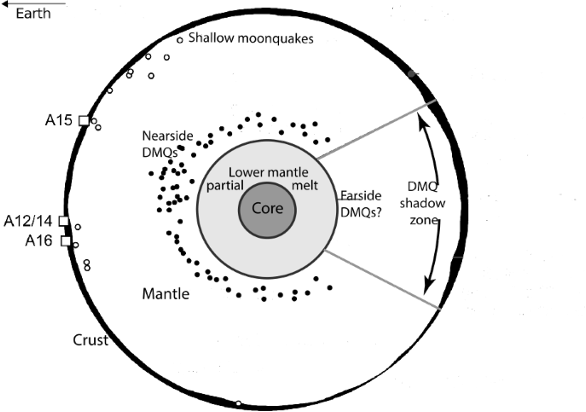
Figure 3: Schematic of the lunar interior showing deep moonquake locations showing the Apollo seismic stations, the lunar core, observed deep moonquake locations and the lack of deep moonquakes on the lunar far-side (From Garcia et al., 2019).
What happened to the deep moonquakes: An aseismic lunar far-side?
One possible explanation for the lack of observed deep moonquakes on the far-side could be that there just aren’t any there – the far-side of the Moon is aseismic.
The existence of any deep moonquakes is peculiar. Deep inside the Moon, the high pressures and temperatures should prevent brittle failure or frictional sliding of faults. Yet, deep moonquakes still happen. The tight clustering and extreme pressures and temperatures of deep moonquakes suggest that some very specific conditions are required to generate them (Frolich and Nakamura, 2009). We still don’t really understand what these conditions are, but maybe those conditions just aren’t there on the far-side
An asymmetric distribution of moonquakes might not be as strange as it sounds – the Moon’s mysterious far-side is very different to the side we gaze up at each night. The crust on the far-side is almost 20km thicker than the near-side (Wieczorek et al., 2013) and also lacks the characteristic dark patches that we see when we look up at the Moon. These dark mare basalts cover about 31% of the near-side but only 1% of the far-side (Moriarty et al., 2021). Even the chemical compositions of the near and far-side differ, with a much higher concentration of heat-producing elements distributed on the near-side (Lawrence, 2003).
What happened to the deep moonquakes: An attenuating lunar interior?
Alternatively, perhaps there are deep moonquakes on the far-side of the Moon, but we just can’t see them. Structures deep in the lunar interior could prevent us from observing deep moonquakes on the far-side from our seismometers on the near-side.
One proposed structure which could be responsible for this is a highly attenuating layer at a depth of around 1000 km. This layer would effectively mask deep moonquakes within 40 degrees of the antipode (Weber et al., 2011; Nakamura 2005). This severe attenuation of seismic waves, along with other remote geophysical observations such as Lunar ranging studies (Khan et al., 2014), suggests that this attenuating layer may be a layer of partial melt sitting just above the lunar core (Fig. 2).
Big Science questions for the next Lunar seismometer
Currently, there is no consensus on the cause of the distribution of deep moonquakes. A new seismic station with a better view of these far-side deep moonquakes is key to understanding this outstanding problem. Luckily, the answer could be close!
As part of NASA’s Artemis programme, to return humans to the Moon by 2025, a new seismometer will be placed on the far-side near the south pole of the Moon (Panning et al., 2021). The very broad-band vertical component seismometer will be the most sensitive seismometer to fly on a planetary mission. Coupled with a 3 component short period seismometer, based on the technology currently monitoring the seismicity of Mars, the instrument will be ideally located to observe any far-side moonquakes which occur.
Whether the distribution of deep moonquakes is created by an aseismic far-side or by the structures deep in the lunar interior, both are likely inherited from the Moon’s early history. Thus untangling the asymmetry of lunar seismicity could help us make fascinating steps forward in understanding the early history of our Moon, building on the insights of the Apollo missions.
References Latham, G., Ewing, M., Dorman, J., Lammlein, D., Press, F., Toksoz, N., … Nakamura, Y. (1971). Moonquakes. Science, 174(4010), 687–692. https://doi.org/10.1126/SCIENCE.174.4010.687 Frohlich, C., & Nakamura, Y. (2009). The physical mechanisms of deep moonquakes and intermediate-depth earthquakes: How similar and how different? Physics of the Earth and Planetary Interiors, 173(3–4), 365–374. https://doi.org/10.1016/j.pepi.2009.02.004 Nakamura, Y. (2005). Farside deep moonquakes and deep interior of the Moon. Journal of Geophysical Research E: Planets, 110(1), 1–12. https://doi.org/10.1029/2004JE002332 Nunn, C., Garcia, R. F., Nakamura, Y., Marusiak, A. G., Kawamura, T., Sun, D., … Zhu, P. (2020, August 1). Lunar Seismology: A Data and Instrumentation Review. Space Science Reviews, Vol. 216. https://doi.org/10.1007/s11214-020-00709-3 Garcia, R. F., Khan, A., Drilleau, M., Margerin, L., Kawamura, T., Sun, D., … Zhu, P. (2019, November 1). Lunar Seismology: An Update on Interior Structure Models. Space Science Reviews, Vol. 215. https://doi.org/10.1007/s11214-019-0613-y Weber, R. C., Lin, P. Y., Garnero, E. J., Williams, Q., & Lognonné, P. (2011). Seismic detection of the lunar core. Science, 331(6015), 309–312. https://doi.org/10.1126/science.1199375 Moriarty, D. P., Dygert, N., Valencia, S. N., Watkins, R. N., & Petro, N. E. (2021). The search for lunar mantle rocks exposed on the surface of the Moon. Nature Communications, 12(1). https://doi.org/10.1038/s41467-021-24626-3 Lawrence, D. J., Elphic, R. C., Feldman, W. C., Prettyman, T. H., Gasnault, O., & Maurice, S. (2003). Small-area thorium features on the lunar surface. Journal of Geophysical Research E: Planets, 108(9), 5102. https://doi.org/10.1029/2003je002050 Panning, M. P., Kedar, S., Bowles, N. E., Calcutt, S. B., Cutler, J., Elliot, J. O., … Yana, C. (2021). Farside Seismic Suite (FSS): First seismic data from the farside of the Moon delivered by a commercial lander. American Geophysical Union Fall Meeting. Retrieved from https://agu.confex.com/agu/fm21/meetingapp.cgi/Paper/839546 Goins, N., Dainty, A., Geophysical, M. T.-J. of, & 1981, undefined. (1981). Seismic energy release of the Moon. Wiley Online Library, 86(B1), 378–388. https://doi.org/10.1029/JB086iB01p00378

